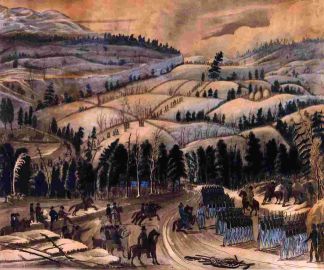The 18th Century Van Rensselaers
American Aristocrats
 The Cherry Hill Van Rensselaers were part of a group of wealthy and powerful families known as the Hudson River manor lords.Under Dutch rule, which lasted from 1624 to 1664, the Dutch West India Company and the States General of the Netherlands granted vast expanses of land–or patroonships–to members of the company who could establish and populate settlements in the colony. Kilian Van Rensselaer (1585-1646), a Dutch merchant and the founder of the dynasty to which generations of Cherry Hill occupants belonged, was one such individual. His roughly 850,000-acre tract, called Rensselaerswyck, was the only patroonship to be successfully established during the Dutch period. The English who took over the colony in 1664 patented a larger (one million acres) Rensselaerswyck and went on to establish about 30 more estates–14 with lordship privileges–occupying more than two million acres.
The Cherry Hill Van Rensselaers were part of a group of wealthy and powerful families known as the Hudson River manor lords.Under Dutch rule, which lasted from 1624 to 1664, the Dutch West India Company and the States General of the Netherlands granted vast expanses of land–or patroonships–to members of the company who could establish and populate settlements in the colony. Kilian Van Rensselaer (1585-1646), a Dutch merchant and the founder of the dynasty to which generations of Cherry Hill occupants belonged, was one such individual. His roughly 850,000-acre tract, called Rensselaerswyck, was the only patroonship to be successfully established during the Dutch period. The English who took over the colony in 1664 patented a larger (one million acres) Rensselaerswyck and went on to establish about 30 more estates–14 with lordship privileges–occupying more than two million acres.
Eighteenth century Hudson River manor lords grew in wealth and power. Like other elites in Boston, New York, Philadelphia, and Baltimore, they engaged in lucrative trading enterprises. The Hudson River families also derived wealth and status from renting their enormous landholdings. Many Hudson River settlers were tenants on these manors–they did not own the land. The English, like the Dutch before them, gave the lords feudal powers–judicial and administrative–over their tenants. Although the judicial and administrative powers were soon removed by the New York General Assembly, the lords maintained extensive power derived from their wealth-producing land and the feudal-like leases they offered. But the feudal rights, short lived as they were, gave them an aura that approximated the Old World aristocracy.
Of course, American elites were never true aristocrats. They were not titled families–lords and counts and dukes. But their wealth and social status that went along with it gave them the needed credentials to qualify as an American version of the real thing. So too did one other essential ingredient of aristocracy– refinement, the visible expression of their class. American aristocrats were regarded as a better sort of people because they disciplined themselves to live a structured life based on manners and virtue. Their goal was to perform perfectly amidst beautiful surroundings. Exquisitely outfitted, they lived in large houses surrounded with beautiful things. They danced, dined, drank, talked, and played cards with elegance and restraint, rather than with what they viewed as the riotous excess and crude manners of those below them. Refinement required taste, but it also required leisure time–for ladies to indulge in ornamental needlework, for gentlemen to learn Latin. This concept of refinement was a key element of aristocracy that would have major influence on generations of Van Rensselaer descendants.